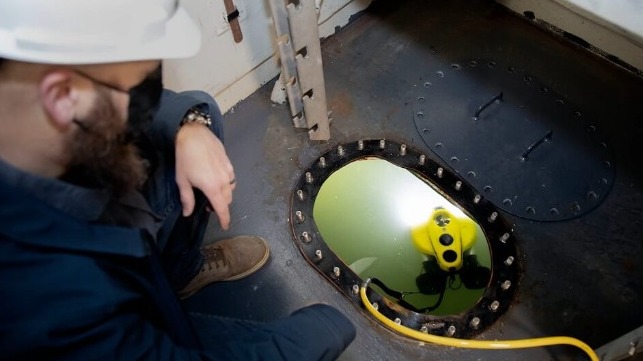
Ensuring the safety and integrity of our tanks is essential for smooth operations. One advanced method we use to keep tanks in top condition is ROV (Remotely Operated Vehicle) inspections. These inspections involve using a remotely controlled vehicle equipped with cameras and sensors to examine tanks without needing to empty or decommission them. This technology makes the inspection process much easier and safer.
ROV inspections provide a thorough look at the inside of tanks, identifying problems that might not be visible during traditional inspections. They help us find issues like rust, cracks, and leaks before they become major problems. By catching these issues early, we can carry out the necessary repairs, avoiding costly damage and downtime.
Incorporating ROV inspections into our regular maintenance routines enhances our ability to maintain safe and efficient tank operations. This technology represents a significant advancement in tank inspection methods and underscores our commitment to using the best tools for maintaining and improving tank safety.
What Are ROV Inspections?
ROV inspections use remotely operated vehicles to check the interior and exterior of tanks. ROVs are equipped with cameras and sensors that allow us to get a clear picture of the tank’s condition without needing to empty it or enter it ourselves. By using ROVs, we can examine hard-to-reach areas and identify potential issues that might be missed during a regular inspection.
These vehicles are controlled from the outside, providing real-time footage and data. This helps us spot cracks, leaks, rust, and other signs of wear and tear. Because the ROV can be deployed without draining the tank, inspections can be done faster and with less disruption to your operations.
Benefits Of Using ROVs For Tank Inspections
Using ROVs for tank inspections offers several benefits.
- Safety: The primary advantage is safety. Since no human entry is needed, the risk of accidents or exposure to harmful substances is eliminated.
- Efficiency: ROV inspections can be done more quickly than manual ones. This means less downtime for your tanks, which can keep your operations running smoothly.
- Cost-effective: Because ROVs can inspect without emptying tanks, you save money on labor and materials needed to clean and empty the tank.
- Thoroughness: ROVs can access tight or submerged areas that might be impossible to inspect otherwise. This ensures a more comprehensive check of the tank’s condition.
Using ROVs enhances the quality of our inspections, making sure that we catch and fix potential problems early. This keeps your tanks in good working condition and extends their lifespan.
How ROV Inspections Detect Common Tank Issues
We utilize Remote Operated Vehicles (ROVs) for detailed inspections of our tanks. These small, unmanned submarines are equipped with cameras and sensors that allow us to see inside tanks without draining them. This method is efficient and minimises downtime, ensuring the tank remains operational while we conduct the inspection. ROVs can detect various issues that might be hard to see during a manual inspection.
For example, ROVs can identify corrosion, cracks, and leaks by capturing high-resolution video footage. The sensors can also measure the thickness of the tank walls, helping us identify areas that may have thinned due to wear and tear. We can detect sediment build-up and other forms of residue that may affect the tank’s performance. By using ROVs, we ensure a comprehensive inspection that covers all areas of the tank, including those that are hard to reach manually.
Steps to Implement ROV Inspections in Your Maintenance Plan
Implementing ROV inspections into your tank maintenance plan is straightforward and beneficial. First, we schedule regular inspections to maintain a consistent check on the tank’s condition. Depending on the tank’s usage and the materials it stores, we might recommend quarterly, bi-annual, or annual inspections. This ensures timely detection of potential issues, allowing for early intervention.
Next, we prepare the tank for inspection. Although ROVs can operate in filled tanks, we recommend a cleaning process beforehand to remove any sediment or residue. This cleaning enhances the visibility of the ROV’s cameras, providing clearer images and more accurate assessments. During the inspection, we monitor the live feed from the ROV, looking for signs of damage, wear, or contamination. Finally, we compile the data collected into a detailed report, highlighting any issues and recommending necessary repairs or maintenance activities.
Conclusion
ROV inspections offer an innovative and efficient way to maintain the integrity of your tanks. By using advanced technology, we can conduct thorough checks that pinpoint potential problems without the need to empty the tanks. This process saves time, reduces operational interruptions, and ensures that any issues are identified and addressed promptly. Regular ROV inspections, combined with proper cleaning and maintenance, help extend the lifespan of the tanks while ensuring they operate safely and efficiently.
For anyone keen to maintain their tanks optimally, incorporating ROV inspections is a wise decision. If you’re interested in learning more about how ROV inspections can benefit your tank maintenance routine, contact ATM Tanks today. Our team is ready to provide expert guidance and support to ensure your tanks remain in top condition. Let’s work together to protect your valuable assets.
- How to Fix Leaks in Your Water Storage Tanks - December 14, 2025
- Effective Techniques for Thorough Tank Cleaning - December 14, 2025
- The Benefits of ROV Tank Inspections for Maintenance - December 14, 2025






